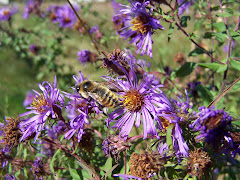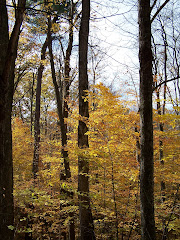It was a beautiful and sunny spring day. The clouds darted across the blue sky, like tossed popcorn in a movie theater. There was a good stiff breeze coming off Lake Champlain. I begain my journy by walking slowly along the edge of a parkng lot. In a cheerful mood I let my eyes wander about searching for something that would satisfy my curiosity for the day. To be honest, I wasn't expecting miracles, being that I was standing only a couple of feet away from blacktop it was unlikely that I would see anything spectacular. But when I glanced up and away from the dry brown leaves that had been covering the ground since October, I was thrilled.
The tree up ahead looked wet. As I moved closer I could see that it was a sugar maple. The "wet" was sap. I inspected the tree further. From about five feet off the ground, there began a series of taps. Each line consisted of 5-7 holes, and they spiraled up into the crown of the tree. Only the holes punched in at around five feet were losing sap. So my theroy is that the sap had not yet warmed up enough to travel up from the roots of the tree to the crown, or the temperature had dropped enough that the sap had returned back down into the roots and lower portions of the tree.
Then it hit me. The yellow-bellied sapsucker, a notorious member of the woodpecker family, had been tapping holes into this tree. It is a relatively uncommon bird, that bores into the bark of trees to emit their sap. This also attracts insects. The birds are ingesting high amounts of sugars and protiens; good things to eat after they've arrived from their migratory winter homes.
This was the first time I had ever noticed evidence of a sapsucker's presence, and it provoked many questions.
Apparently the yellow-bellied sapsucker is seen as pests in orchards, because they eventually girdle the trees, or open them up to diseases, or insect infestations. I would presume that maple sugarers dont have high esteam for these attractively patterned woodpeckers either. But I for one am a fan. I wonder if the little bird that drilled into this tree would decide to nest near here, or if he/she was merely passing through.
I snapped a few photos before moving on. I'll know what to look for too, in my future expeditions. I check trees for signs of yellow-bellied sap suckers now. Hoping to one day see the strange and famliar markings drilled into the bark of trees.
Subscribe to:
Post Comments (Atom)






No comments:
Post a Comment